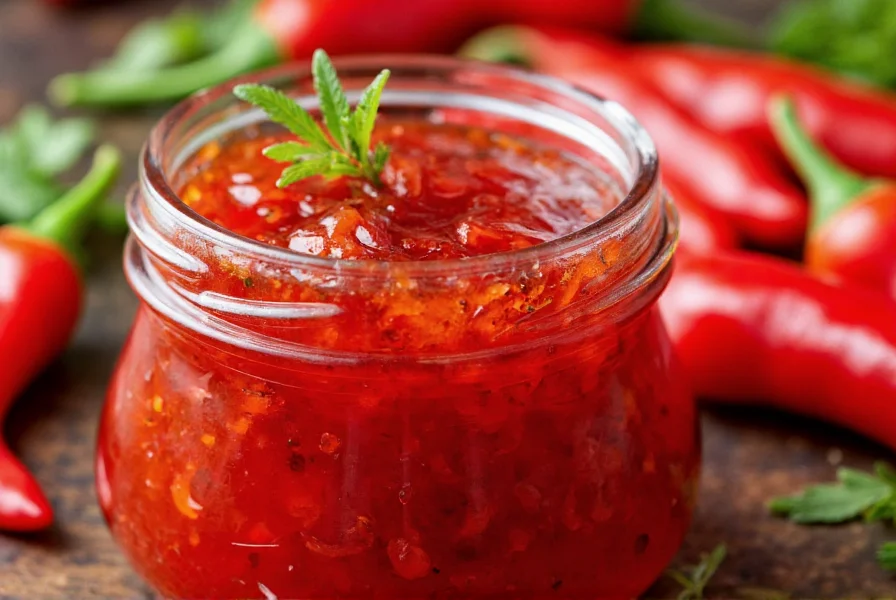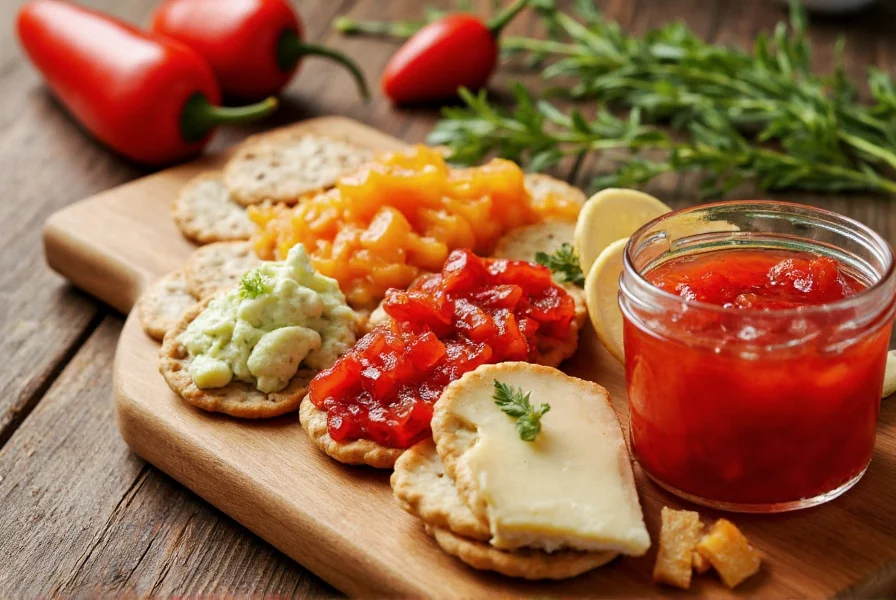Understanding how to maximize this vibrant condiment's potential can transform ordinary meals into extraordinary culinary experiences. Whether you're hosting a gathering or elevating weeknight dinners, red pepper jelly's unique flavor profile bridges the gap between sweet preserves and spicy relishes, offering endless pairing possibilities that satisfy diverse palates.
What Exactly Is Red Pepper Jelly?
Red pepper jelly represents a harmonious blend of sweet and spicy elements, typically crafted from red bell peppers, sometimes combined with hotter varieties like cayenne or jalapeño for added complexity. The standard preparation involves cooking chopped peppers with vinegar, sugar, and pectin until achieving that perfect gel consistency. Unlike traditional fruit preserves, this condiment delivers a distinctive flavor journey—beginning with initial sweetness that gradually reveals a gentle warmth.
The magic happens through careful balancing of ingredients. Too much sugar overwhelms the pepper's character, while excessive heat dominates the delicate sweetness. Professional chefs and home preservers alike emphasize precise measurements and controlled cooking times to maintain that ideal sweet-heat equilibrium that makes red pepper jelly so versatile in culinary applications.

Essential Pairing Combinations for Red Pepper Jelly
Mastering red pepper jelly pairings elevates your culinary repertoire significantly. The condiment's versatility shines when matched with complementary flavors that enhance rather than compete with its distinctive profile. Consider these expert-recommended combinations that consistently delight taste testers and food critics alike.
| Food Category | Top Pairings | Recommended Serving Method |
|---|---|---|
| Cheeses | Cream cheese, brie, goat cheese, sharp cheddar | Thin layer on cheese board or mixed into softened cheese |
| Meats | Pork tenderloin, grilled chicken, turkey, ham | As glaze during last 5 minutes of cooking or as dipping sauce |
| Appetizers | Phyllo cups, crostini, spring rolls | Base layer topped with cheese or protein |
| Breakfast | Cream cheese bagels, scrambled eggs, sausage | Spread or dollop alongside main items |
Cheese Pairing Science Explained
The chemistry behind red pepper jelly and cheese pairings reveals why this combination works so well. Creamy, mild cheeses like cream cheese or brie provide a cooling counterpoint to the jelly's gentle heat, creating a balanced flavor experience. The fat content in these cheeses helps moderate the capsaicin (the compound responsible for pepper heat), while the jelly's acidity cuts through the richness of the cheese.
For cheese boards, arrange your selections thoughtfully: place the red pepper jelly in a small bowl surrounded by an alternating pattern of cheeses, crackers, and complementary elements like nuts or fresh fruit. This visual arrangement guides guests through a curated tasting experience that showcases how the jelly enhances each cheese variety differently.
Culinary Applications Beyond Traditional Pairings
While classic pairings remain popular, innovative chefs have expanded red pepper jelly's role in modern cuisine. Try these creative applications that demonstrate the condiment's remarkable versatility:
- Marinade base - Combine with olive oil, garlic, and herbs for chicken or pork
- Salad dressing component - Whisk with vinegar and oil for a sweet-spicy vinaigrette
- Glaze for roasted vegetables - Toss with carrots or sweet potatoes before roasting
- Cocktail mixer - Blend with citrus juices for unique sweet-spicy beverages
- Baking ingredient - Swirl into cheesecake batter or use as filling for pastries
Professional food developers note that red pepper jelly's pectin content makes it particularly valuable as a natural thickener in sauces and reductions, eliminating the need for additional starches or gums in many recipes.

Storage Guidelines for Maximum Freshness
Proper storage significantly extends red pepper jelly's shelf life and preserves its vibrant flavor profile. Commercially prepared jelly typically remains fresh for 12-18 months unopened, while homemade versions last 1-2 years when properly canned using tested preservation methods.
Once opened, refrigerate your red pepper jelly and consume within 3-4 months for optimal quality. Always use clean utensils when serving to prevent contamination. For extended storage of homemade batches, consider freezing in ice cube trays then transferring to freezer bags—this portioned approach allows you to thaw only what you need for specific recipes.
Homemade vs. Store-Bought: Making an Informed Choice
Both homemade and commercial red pepper jelly options offer distinct advantages depending on your needs and culinary goals. Understanding these differences helps you select the best option for each occasion.
Artisanal producers often create small-batch red pepper jelly with carefully selected pepper varieties and natural ingredients, avoiding preservatives and artificial colors. These premium products typically feature more complex flavor profiles but come at a higher price point. When selecting store-bought options, examine ingredient lists for minimal additives and balanced sugar-to-pepper ratios.
For home preparation, the process requires attention to food safety protocols, particularly proper canning techniques to prevent spoilage. Many culinary experts recommend starting with tested recipes from reputable sources like university extension services to ensure both safety and optimal flavor development.
Seasonal Considerations for Red Pepper Jelly
The quality of red pepper jelly varies with seasonal availability of fresh peppers. Peak season for red bell peppers typically runs from late summer through early fall, when they're most abundant and flavorful. During these months, homemade preparations benefit from superior ingredient quality, resulting in brighter color and more pronounced pepper flavor.
Commercial producers often blend peppers from different growing regions to maintain consistent quality year-round, but discerning palates may notice subtle flavor variations between seasonal batches. For special occasions, consider seeking out locally produced red pepper jelly from farmers' markets during peak harvest season for the freshest, most vibrant product.
Frequently Asked Questions
What cheeses pair best with red pepper jelly?
Cream cheese represents the classic pairing for red pepper jelly, creating the beloved appetizer combination found at countless gatherings. Beyond cream cheese, mild goat cheese, brie, and sharp white cheddar offer excellent complementary flavors. The key is balancing the jelly's sweetness and heat with cheeses that provide either creamy contrast or complementary sharpness without overwhelming the delicate pepper flavor.
Can red pepper jelly be used as a meat glaze?
Absolutely—red pepper jelly works exceptionally well as a glaze for pork tenderloin, chicken breasts, and ham. For best results, combine equal parts jelly and apple cider vinegar with a splash of soy sauce, then brush onto meats during the final 5-10 minutes of cooking. The sugar content helps create a beautiful caramelized exterior while the acidity balances the richness of the meat. Avoid applying too early in the cooking process, as the sugars can burn.
How long does opened red pepper jelly last in the refrigerator?
Properly stored in a sealed container, opened red pepper jelly maintains optimal quality for 3-4 months in the refrigerator. Always use clean utensils when serving to prevent contamination. You'll know it's time to discard if you notice any mold growth, significant color changes, or off odors. For extended storage, consider freezing in ice cube trays then transferring portions to freezer bags—this method preserves quality for up to 12 months.
What's the difference between red pepper jelly and jalapeño jelly?
While both are spicy-sweet condiments, red pepper jelly typically uses milder red bell peppers as the primary ingredient, sometimes blended with small amounts of hotter peppers for complexity. Jalapeño jelly relies predominantly on jalapeños, resulting in more consistent heat throughout. Red pepper jelly generally offers a sweeter profile with gradual heat development, while jalapeño jelly delivers more immediate spiciness. The choice between them depends on your preferred heat level and intended application.
Can I make red pepper jelly less spicy if it's too hot?
Yes, several approaches can mellow excessive heat in red pepper jelly. Gently heating the jelly with additional sugar (¼ cup at a time) helps balance the spiciness. Alternatively, mixing with mild apple jelly in a 1:1 ratio creates a more approachable flavor profile while maintaining the distinctive pepper character. For immediate serving, pairing with cooling elements like cream cheese or Greek yogurt counteracts the heat effectively without altering the jelly itself.











 浙公网安备
33010002000092号
浙公网安备
33010002000092号 浙B2-20120091-4
浙B2-20120091-4